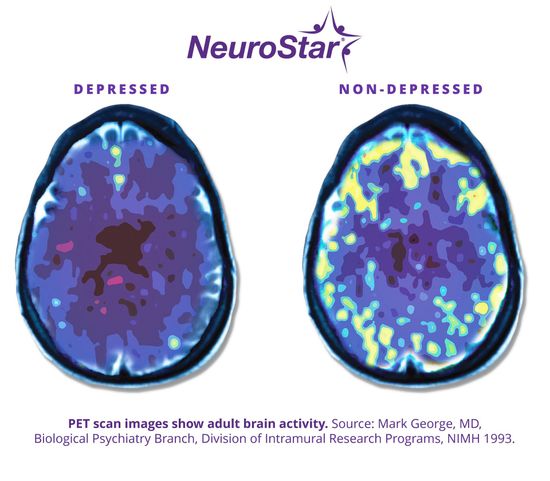About NeuroStar® TMS Therapy
NeuroStar® uses transcranial magnetic stimulation (TMS) to stimulate specific areas of the brain that are underactive in individuals with depression. Unlike electroconvulsive therapy (ECT), TMS is non-invasive and does not require anesthesia or cause memory loss. While the exact cause of depression remains unclear, the leading scientific theory suggests it involves an imbalance in the brain’s neurotransmitters—chemical messengers that help regulate mood by transmitting signals between brain cells.
HOW IT WORKS
Before Treatment
You will be seated comfortably in the treatment chair. A small, curved magnetic coil will be gently positioned on your head.
During Treatment
NeuroStar provides targeted magnetic stimulation precisely to designated areas of the brain. You'll notice a clicking sound and experience a tapping feeling on your head.
After Treatment
NeuroStar Advanced Therapy: Based on your doctor’s advice, each session lasts between 19 and 37 minutes. You can return to your regular activities right after.
Since there are no impacts on your alertness or memory, you’re able to drive yourself to and from your treatment sessions.
PET BRAIN SCAN
These images are courtesy of Mark George. (Source: Mark George, M.D. Biological Psychiatry Branch Division of Intramural Research Programs, NIMH 1993.)
NeuroStar does not own these images, but we have been given permission to use them. These images are NOT scans from TMS patients or treatments.
These images depict brain activity in a depressed brain versus a non-depressed brain.

TESTIMONIALS
Neurostar changed my life
Mariah, New York
It shined a new light on my life
Bart, New York
FAQs
What is Transcranial Magnetic Stimulation?
Transcranial magnetic stimulation, often referred to as TMS is a noninvasive procedure that uses
magnetic fields to stimulate nerve cells in the brain to improve symptoms of depression. TMS is typically used when antidepressant medications haven’t been effective, have ceased working, or as an
alternative to medication.
How does TMS work?
TMS involves delivering magnetic pulses to specific parts of the brain.
How long is TMS treatment?
A typical initial course of treatment is about 19-37 minutes daily over 4-6 weeks.
Is TMS Therapy covered by my insurance?
A vast majority of commercial and Medicare plans have recognized the effectiveness of treating depression with TMS Therapy and now cover TMS as part of their plans.
Is TMS Therapy a good alternative for patients who cannot tolerate the side effects of antidepressant medications?
TMS does not circulate in the blood throughout the body, so it does not have side effects like weight
gain, sexual dysfunction, nausea, dry mouth, sedation, etc. The most common side effects reported
during clinical trials were headache and scalp discomfort —generally mild to moderate—occurring
less frequently after the first week of treatment.
Is TMS Therapy like other alternative therapies that use magnets to treat some illnesses?
No. TMS Therapy involves a unique method of using pulsed magnetic fields for a therapeutic benefit.
The intensity of the magnetic field is similar to that of an MRI. These techniques differ radically from
the popular use of low intensity, static magnetic fields. Those products deliver weak and undirected
static fields that are not capable of activating brain cells. The activation and stimulation of brain cells
is a key part of why TMS is so effective.

